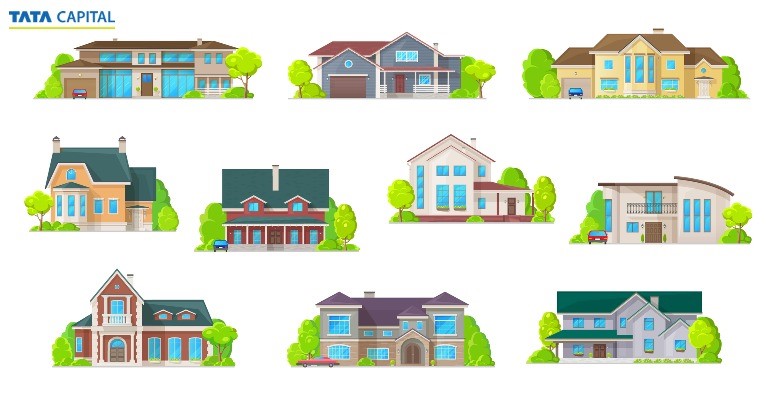Tata Capital > Blog > Loan for Home > What is Pre EMI and How to Calculate It?
When it comes to buying a home, many people opt for a home loan. However, most people don’t know that home loan repayment can be made in multiple ways.
You can choose between pre-EMI and Full EMI options, depending on your preference. If you’re planning on getting a home loan, it’s essential to understand these options to manage your finances efficiently while the property is constructed.
In this article, we’ll take a deep dive into what pre-EMI is, its advantages, and how to calculate it.
A pre-EMI is a repayment scheme banks and financial institutions offer for home loans for under-construction properties.
Under this scheme, you’ll only have to pay the interest on the amount disbursed by the lender. This means that during the construction phase of the property, you’ll not have to pay the principal amount of the loan. Instead, you’ll only have to pay the interest portion of the loan as EMIs. This interest-only payment is called pre-EMI.
However, since the disbursal is based on completing different project phases, the lender may release the full amount in 3-6 tranches. Once you take possession of the property, your actual repayments start, and you’ll have to pay the full EMI (principal amount + interest).
Now that you’re aware of what pre-EMI meaning, let’s look at some of its benefits.
1 Lower EMIs
During the construction phase of the property, you only have to pay the interest on the disbursed amount. This leads to lower EMIs during the pre-EMI period, which helps you manage your finances effectively.
2 Reduced financial burden
The pre-EMI scheme is great for people who are renting a home but want to buy a house. It lets them pay only the interest on their home loan till the property is ready.
This makes it easier to afford and plan for the future, as they can expect their income to increase before starting full EMI payments.
3 pre-EMI tax benefit
Under the Income Tax Act 24, you can get Pre EMI tax benefits when you choose it as an option for your home loan. However, there’s a catch! You can’t claim a tax deduction on the interest you pay during the construction period.
But once you own the property, you can claim the interest paid during construction in five equal installments for a tax deduction, up to a limit of Rs. 2 lakhs per year.
1 Loan disbursal
If you select the Full-EMI option, you’ll receive the entire loan amount in one go. However, if you choose the pre-EMI option, the loan amount is disbursed in installments.
2 Interest rate
The interest of pre-EMI is calculated on the loan amount disbursed. On the other hand, the full-EMI interest is calculated on the principal loan amount.
3 Repayment period
Choosing Full-EMI over pre-EMI leads to faster debt repayment as monthly installments cover a larger portion of the principal amount.
4 Principal Amount
The Full-EMI principal loan amount and loan tenure decrease with each monthly payment. However, there is no impact on the loan tenure, principal loan amount, or interest rate under the pre-EMI option.
5 EMI payments
The pre-EMI monthly payments commence as soon as construction begins. Whereas full-EMI payments only start once you’ve taken possession of the property after it is completed.
To understand how to calculate pre-EMI, let’s take an example.
Let’s assume Rohan avails a loan of INR 20 lakhs for 20 years at an 8% interest rate. He takes this loan for a new under-construction property that’ll be completed within 2 years. So, in the first tranche, the lender disburses Rs 4 lakhs.
Here’s what it’ll look like:
| Disbursement Timeline | Disbursed Amount | Total Disbursed Amount | pre-EMI (Rs) | Regular EMIs(start after 24 months) |
| Initial | 4,00,000 | 4,00,000 | 2,666 | 16,729 |
| 6 months | 4,00,000 | 8,00,000 | 5,333 | 16,729 |
| 12 months | 4,00,000 | 12,00,000 | 8,000 | 16,729 |
| 18 months | 4,00,000 | 16,00,000 | 10,667 | 16,729 |
| 24 months | 4,00,000 | 20,00,000 | 16,729 | 16,729 |
The lender disburses the principal amount in 5 tranches based on the completion of the project, with the final instalment being disbursed upon possession of the house. It’s important to note that pre-EMI isn’t included in the original tenor of the loan, and it extends beyond the loan’s actual term. As a result, Rohan ends up paying more interest than he would otherwise.
The stark difference between full EMI and pre-EMI, as per the above example, is that you can repay the loan within 20 years in the former. While in the latter, you’ll repay the loan in 22 years.



Home Loan Balance Transfer – Benefits and Factors to Consider

Difference Between Home Extension Loan And Home Loan Extension


Everything You Need To Know About Processing Fees For Home Loan

What is the difference between a Villa, Bungalow, and Duplex apartment?

Pros and Cons: Higher Floor vs Lower Floor living – Which is better?

